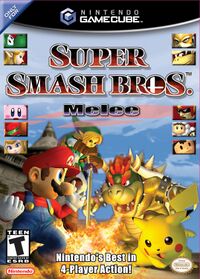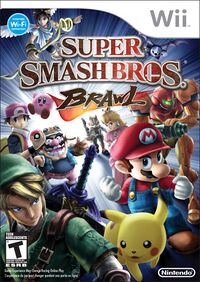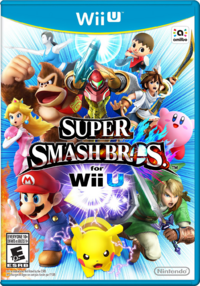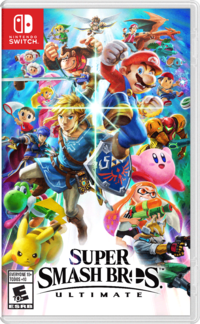Super Smash Bros. (series): Difference between revisions
No edit summary |
|||
| (27 intermediate revisions by 11 users not shown) | |||
| Line 1: | Line 1: | ||
{{SmashWiki}} | {{DISPLAYTITLE:''Super Smash Bros.'' (series)}}{{SmashWiki}} | ||
The '''''Super Smash Bros.'' series''' is a collection of six (five if ''Super Smash Bros. for Nintendo 3DS'' and ''Super Smash Bros. for Wii U'' are counted collectively) fighting titles featuring a crossover of [[Nintendo]]-series fighters battling each other. The series was created and has been directed by ''[[Kirby (series)|Kirby]]''{{'}}s game designer and director [[Masahiro Sakurai]], first as part of [[HAL Laboratory]] and then later under contract through his solo operation [[SmashWiki:Sora Ltd.|Sora Ltd.]] Each game in the series has received critical acclaim from the wider gaming community for its unique and innovative play-style, and its competitive aspects. Each game in the series also features at least [[Kirby]] as a playable fighter, and borrows other elements from the ''Kirby'' series for stages, items, and other minutia. | |||
== Games == | |||
Since the release of the original ''Super Smash Bros.'', every major Nintendo home console (and [[Nintendo 3DS|one handheld]]) has seen a release of an entry in the series. The games are as follows: | |||
=== ''Super Smash Bros.'' === | |||
[[File:SSB Box Art.jpg|thumb|200px|North American cover for ''Super Smash Bros.'']] | |||
{{SmashWiki|Super Smash Bros.}} | |||
{{main|Super Smash Bros.}} | |||
''[[Super Smash Bros.]]'' first released on the [[Nintendo 64]] in 1999. It features 12 playable characters from various Nintendo franchises, including [[SmashWiki:Mario|Mario]], [[SmashWiki:Donkey Kong|Donkey Kong]], [[SmashWiki:Link|Link]], [[SmashWiki:Fox McCloud|Fox]], and [[SmashWiki:Pikachu|Pikachu]] among others. This game further developed on concepts introduced in ''[[Kirby Super Star]]'' (and proposed for the original ''[[Kirby's Dream Land]]''<ref>[https://www.youtube.com/watch?v=PfOqBTV32_0 初代『星のカービィ』開発秘話 【雑談】 — 桜井政博のゲーム作るには] (official English version: [https://www.youtube.com/watch?v=ZUY2AtBD6Sk Development Secrets of the Original Kirby <nowiki>[Grab Bag]</nowiki> — Masahiro Sakurai on Creating Games]; also appearing in print in the 2017/05/11–18 issue of ''Weekly Famitsu'' as a special edition of Sakurai's "Think about the Video Games" column <nowiki>[</nowiki>[https://www.famitsu.com/news/201705/17132636.html 1/2], [https://www.famitsu.com/news/201705/17132636.html?page=2 2/2]; Wayback Machine snapshots exist of [https://web.archive.org/web/1000/www.famitsu.com/news/201705/17132636.html 1/2], [https://web.archive.org/web/1000/www.famitsu.com/news/201705/17132636.html?page=2 2/2]<nowiki>]</nowiki></ref>) into a "platform fighter" where the goal is not to reduce opponents' [[Health|HP]] to 0, but to knock them off the stage, with more [[damage]] resulting in being launched further when hit. All fighters are given the ability to jump in midair at least once, have simple directional attacks and special moves, have the ability to shield, grab, and roll out of the way, and use items that appear on stage. Most stages are defined by unorthodox layouts with floating platforms and/or stage hazards which need to be contended with. | |||
== | [[Kirby]] was introduced as a playable fighter here, alongside his "home" stage [[SmashWiki:Dream Land (SSB)|Dream Land]]. Kirby's most distinct attribute as a fighter is the ability to inhale his opponents and copy their neutral special attack (or steal an ability obtained by another Kirby). | ||
{{clear}} | |||
=== ''Super Smash Bros. Melee'' === | |||
[[File:SSBM-Box Art.jpg|thumb|200px|North American cover for ''Super Smash Bros. Melee'']] | |||
{{SmashWiki|Super Smash Bros. Melee}} | |||
{{main|Super Smash Bros. Melee}} | |||
''[[Super Smash Bros. Melee]]'' first released in 2001 for the [[Nintendo GameCube]]. It expands the roster to a total of 26 characters, with notable additions including [[SmashWiki:Princess Peach|Peach]], [[SmashWiki:Bowser|Bowser]], [[SmashWiki:Princess Zelda|Zelda]], and the [[SmashWiki:Ice Climbers|Ice Climbers]]. The gameplay was adjusted to generally result in faster-paced fighting, along with giving fighters an additional (forward-directional) special move, the ability to hold smash attacks for more power, the ability to dodge in place or in midair, and the ability to pummel grabbed opponents and throw them upward or downward, among other changes. The main gameplay additions to the series were an [[SmashWiki:Adventure Mode (SSBM)|Adventure Mode]], [[SmashWiki:All-Star Mode|All-Star Mode]], [[SmashWiki:Event match|Event matches]], and [[SmashWiki:Stadium|Stadium]] with multiple smaller modes. The concept of [[SmashWiki:Trophy|collectible trophies]] was also introduced to the series here. | |||
While no new ''Kirby''-series characters were introduced in this game, Kirby himself received a few changes, including gaining the use of [[Hammer]] as a special move and his [[Burning]] fireball attack as a [[dash]] attack. Two new ''Kirby''-series stages were introduced as well—those being [[SmashWiki:Green Greens|Green Greens]] and [[SmashWiki:Fountain of Dreams|Fountain of Dreams]]. | |||
{{clear}} | |||
=== ''Super Smash Bros. Brawl'' === | |||
[[File:SSBB Cover.jpg|thumb|200px|North American cover for ''Super Smash Bros. Brawl'']] | |||
{{SmashWiki|Super Smash Bros. Brawl}} | |||
{{main|Super Smash Bros. Brawl}} | |||
''[[Super Smash Bros. Brawl]]'' first released in 2008 for the Nintendo [[Wii]]. It was the first game in the series to be developed by Sora Ltd. rather than HAL Laboratory. The game features 35 playable fighters, though some characters from previous games were dropped. Notable newcomers included [[SmashWiki:Pit|Pit]], [[SmashWiki:Lucas|Lucas]], [[SmashWiki:Pokémon Trainer|Pokémon Trainer]], [[SmashWiki:Solid Snake|Snake]], and [[SmashWiki:Sonic the Hedgehog|Sonic]]. The game was adjusted to be more approachable to newcomers than ''Melee'' was by making it generally slower and more forgiving in its physics and gameplay mechanics, such as giving characters more ability to recover if launched off stages, making dodging safer, and introducing more powerful items that can turn the tide of battle. The most notable item inclusion (one that would remain for the rest of the series) was the [[SmashWiki:Smash Ball|Smash Ball]], which allows whoever grabs it to unleash their [[SmashWiki:Final Smash|Final Smash]]—an often powerful attack that can quickly defeat other fighters. | |||
{{ | ''Super Smash Bros. Brawl'' added many new gameplay additions over the previous games, but by far the largest was the revamped Adventure Mode, known as [[SmashWiki:Adventure Mode: The Subspace Emissary|The Subspace Emissary]]. This expansive [[Story Mode|story mode]] tells a tale of the ''Super Smash Bros.'' fighters gathering together to stop an army of extra-dimensional invaders led by a winged god-like figure named [[SmashWiki:Tabuu|Tabuu]] from dismantling their world and dragging it piece-by-piece in to their dimension (known as "Subspace"). The story is told entirely without dialogue through many pre-rendered [[cutscene]]s featuring all (except three) of the fighters. The levels themselves follow design elements from the ''Kirby'' series (specifically ''Kirby Super Star''), and even includes the [[Halberd]] as one of the principal settings. Aside from this mode, ''Brawl'' also introduced a [[SmashWiki:Stage Builder|Stage Builder]] and the ability for [[Online features|online play]], among other features. | ||
Among the newcomers to this game were two ''Kirby''-series characters—[[King Dedede]] and [[Meta Knight]]. Both of them share Kirby's ability to jump multiple times in midair, though King Dedede specializes as a heavyweight brawler with a long reach using his hammer, while Meta Knight excels in speedy sword swipes and unmatched aerial mobility. Meta Knight in particular would quickly become infamous as the undisputed best fighter in the competitive scene for ''Brawl'', often being outright banned from tournaments. Kirby himself received a few changes from the previous game, having his dash attack changed into a spinning kick similar to his [[Yo-Yo]] "Break Spin" attack and his Hammer special move being changed in how it swings. Additionally, a new ''Kirby''-series stage was introduced: [[SmashWiki:Halberd|Halberd]]. | |||
{{clear}} | |||
=== ''Super Smash Bros. for Nintendo 3DS / Wii U'' === | |||
[[File:SSB4 Cover.png|thumb|200px|North American cover for ''Super Smash Bros. for Wii U'']] | |||
{{SmashWiki|Super Smash Bros. 4}} | |||
{{main|Super Smash Bros. for Nintendo 3DS / Wii U}} | |||
''[[Super Smash Bros. for Nintendo 3DS / Wii U]]'' are two games developed concurrently by Sora Ltd. and Bandai Namco and released in 2014. The first (''[[SmashWiki:Super Smash Bros. for Nintendo 3DS|Super Smash Bros. for Nintendo 3DS]]'') came out for the [[Nintendo 3DS]] in September/October 2014 in most regions, while the second (''[[SmashWiki:Super Smash Bros. for Wii U|Super Smash Bros. for Wii U]]'') came out for the [[Wii U]] in November/December 2014. Despite being two separate games for separate systems, the two share the same roster of up to 58 fighters, with most returning from ''Brawl'', some returning from ''Melee'' who were not in ''Brawl'', and seven in particular being paid downloadable content released after launch. Notable additions included the ''[[nookipedia:Animal Crossing (series)|Animal Crossing]]'' [[SmashWiki:Villager|Villager]], [[SmashWiki:Little Mac|Little Mac]], [[SmashWiki:Mega Man|Mega Man]], [[SmashWiki:Pac-Man|PAC-MAN]], [[SmashWiki:Ryu|Ryu]], and [[SmashWiki:Cloud Strife|Cloud Strife]]. | |||
The gameplay for both of these titles is very similar to that of ''Brawl'', though with subtle changes made to the game's mechanics to allow for a better distinction between "casual" and "competitive" play. On the casual side, many more powerful items and hazard-ridden stages would be added for frenetic gameplay where luck is just as important as skill, while on the competitive side, regular one-on-one matches are more deterministic, with less severe dependence on luck-based factors. While an extensive story mode like in ''Brawl'' did not return in either of these games, existing game modes and features were expanded upon and a few new ones were added. Each version of the game got different modes, with ''for 3DS'' getting a mode inspired by [[City Trial]] called [[SmashWiki:Smash Run|Smash Run]] and ''for Wii U'' getting a board game-like mode called [[SmashWiki:Smash Tour|Smash Tour]]. The Wii U version would also gain support for battles between up to eight players and a more elaborate stage builder with the ability to "free-draw" in platforms. To cater to competitive players, online play was divided between two modes: "For Fun" and "For Glory", with the latter featuring battles with no items and standard "two-stock" fights on flat hazardless stages (referred to as [[SmashWiki:Ω form|Ω form]]). | |||
No new ''Kirby''-series characters appeared in either of these games, but all three returned from ''Brawl'' with some changes to their movesets. Kirby's Hammer special move was changed once again to [[Hammer Flip]], gaining the ability to charge up a powerful fiery attack. His Final Smash was changed to the [[Ultra Sword]] from ''[[Kirby's Return to Dream Land]]''. King Dedede had his reach with his hammer reduced slightly, and his side special attack changed from throwing random minions to only throwing [[Gordo]]s which can be knocked back and forth. His Final Smash was changed into [[SmashWiki:Dedede Burst|Dedede Burst]], which involves him pummeling his foes with his hammer before lobbing a giant bomb out of his hammer to blow them up. Meta Knight retains his abilities, but was generally made slower with more predictable special moves. He also lost the ability to glide out of his upwards special move [[Shuttle Loop]]. Two new ''Kirby''-series stages were added, but they were split between each version: ''for 3DS'' received [[SmashWiki:Dream Land GB|Dream Land GB]] and ''for Wii U'' received [[SmashWiki:The Great Cave Offensive|The Great Cave Offensive]]. | |||
{{clear}} | |||
=== ''Super Smash Bros. Ultimate'' === | |||
[[File:Smash Ultimate Box Art.png|thumb|200px|North American cover for ''Super Smash Bros. Ultimate'']] | |||
{{SmashWiki|Super Smash Bros. Ultimate}} | |||
{{main|Super Smash Bros. Ultimate}} | |||
''[[Super Smash Bros. Ultimate]]'' released in late 2018 for the [[Nintendo Switch]]. With the tagline "Everyone is here!", it features every single fighter from previous ''Super Smash Bros.'' games in addition to many new ones, bringing the total count to more than 80 (the exact number depends on the definition of a distinct fighter). More emphasis than usual was placed on bringing in characters from 3rd party franchises and/or long-standing fan requests, with notable additions including [[SmashWiki:Ridley|Ridley]], [[SmashWiki:Joker|Joker]] from ''[[wikipedia:Persona 5|Persona 5]]'', [[SmashWiki:Banjo & Kazooie|Banjo & Kazooie]], [[SmashWiki:Terry Bogard|Terry Bogard]], [[SmashWiki:Steve|Steve]] from ''[[wikipedia:Minecraft|Minecraft]]'', and [[SmashWiki:Sora|Sora]] from ''[[wikipedia:Kingdom Hearts|Kingdom Hearts]]''. The game mechanics are based on the previous titles, but have been further tweaked to encourage a distinction between casual and competitive play, with a generally faster pace than before (though not quite as fast as ''Melee''). | |||
One of the largest additions in this title is a new expansive Adventure Mode called [[SmashWiki:Adventure Mode: World of Light|World of Light]]. It makes use of the new main collectible items in this game called [[SmashWiki:Spirit|Spirits]], which are representations of various video game characters who enhance the abilities of fighters when paired with them (and who replace trophies from previous games). Instead of featuring extensive levels facing hordes of low-level foes like in The Subspace Emissary, World of Light instead has the player traversing a massive set of [[World Map]]s and engaging in a series of Event Match-style battles with special conditions in order to unlock more spirits and rescue fighters. The fighters and spirits can be upgraded over the course of the adventure using in-game resources and currencies. The story mode itself has multiple endings, with only one being considered the "true" ending. Other returning modes in ''Ultimate'' have been reworked or revamped, with improvements to the Stage Builder and to Online modes in particular. | |||
Once again, ''Ultimate'' had no new characters from the ''Kirby'' series, but all returned from the previous titles with further changes to their movesets. Kirby once again had his dash attack changed to the Burning fireball as it was in ''Melee'', though it was made more powerful and no longer causes him to fall off ledges. King Dedede had his Final Smash changed once again to [[SmashWiki:Dede-Rush|Dede-Rush]], which traps fighters in a caged boxing ring where [[Masked Dedede]] pummels them repeatedly with his special attacks. Meta Knight was also given a new Final Smash in the form of [[SmashWiki:Darkness Illusion|Darkness Illusion]], causing him to gain a second pair of wings and pummel his foes in a similar style to [[Upper Calibur]]. No new ''Kirby'' series stages were added, though every stage from previous games made a comeback with new graphical updates. | |||
== Relation to the ''Kirby'' series == | |||
[[File:KaTAM Rainbow Route Goal 1.png|thumb|250px|Kirby battling [[Master Hand]] in ''[[Kirby & The Amazing Mirror]]'' (Master Hand originated in ''Super Smash Bros.'')]] | |||
Since HAL Laboratory was the main developer for the first two ''Super Smash Bros.'' games, and Masahiro Sakurai was the original creative mind behind both that and the ''Kirby'' series, the two series share a lot of design aspects and have been closely intertwined, though this has become gradually less true over time with Sakurai's departure from HAL Laboratory in the mid 2000s. There are many ways in which the ''Super Smash Bros.'' series has influenced the ''Kirby'' series since the former's inception, but the following are the most notable: | |||
*Kirby's principal voice actor [[Makiko Ohmoto]] first voiced him in ''Super Smash Bros.'' on the Nintendo 64. It is also arguable that Kirby's modern rounder appearance was largely shaped by his appearance in that title (which was the first finished game to depict him in 3-D). | |||
*The [[Smash Bros.]] Copy Ability is directly inspired by Kirby's moveset in the ''Super Smash Bros.'' series, and has appeared in multiple games. | |||
*[[Master Hand]] and [[Master Hand & Crazy Hand|Crazy Hand]] have appeared in ''[[Kirby & The Amazing Mirror]]'' as foes for Kirby to fight. | |||
*The modern designs of Meta Knight and the Halberd largely take their cues from ''Super Smash Bros.'' (specifically from ''Brawl'' onward). | |||
*Many arrangements of ''Kirby'' songs from ''Super Smash Bros.'' (particularly ''Melee'') inspired arrangements or remixes in subsequent ''Kirby'' games (the most notable ones being the ''Melee'' arrangement of [[Green Greens (theme)|Green Greens]] and [[Fountain of Dreams (theme)|Fountain of Dreams]] (originally [[Gourmet Race (theme)|the Gourmet Race theme]])). | |||
*The final release version of ''[[Kirby Air Ride]]'' was built using the same base engine as ''Super Smash Bros. Melee''. | |||
{{clear}} | |||
{{ref}} | |||
{{Navbox-SSB}} | |||
{{Navbox-HAL}} | |||
[[Category:Series]] | |||
[[Category:Super Smash Bros. series]] | |||
Latest revision as of 23:47, 26 April 2024
The Super Smash Bros. series is a collection of six (five if Super Smash Bros. for Nintendo 3DS and Super Smash Bros. for Wii U are counted collectively) fighting titles featuring a crossover of Nintendo-series fighters battling each other. The series was created and has been directed by Kirby's game designer and director Masahiro Sakurai, first as part of HAL Laboratory and then later under contract through his solo operation Sora Ltd. Each game in the series has received critical acclaim from the wider gaming community for its unique and innovative play-style, and its competitive aspects. Each game in the series also features at least Kirby as a playable fighter, and borrows other elements from the Kirby series for stages, items, and other minutia.
Games[edit]
Since the release of the original Super Smash Bros., every major Nintendo home console (and one handheld) has seen a release of an entry in the series. The games are as follows:
Super Smash Bros.[edit]
- Main article: Super Smash Bros.
Super Smash Bros. first released on the Nintendo 64 in 1999. It features 12 playable characters from various Nintendo franchises, including Mario, Donkey Kong, Link, Fox, and Pikachu among others. This game further developed on concepts introduced in Kirby Super Star (and proposed for the original Kirby's Dream Land[1]) into a "platform fighter" where the goal is not to reduce opponents' HP to 0, but to knock them off the stage, with more damage resulting in being launched further when hit. All fighters are given the ability to jump in midair at least once, have simple directional attacks and special moves, have the ability to shield, grab, and roll out of the way, and use items that appear on stage. Most stages are defined by unorthodox layouts with floating platforms and/or stage hazards which need to be contended with.
Kirby was introduced as a playable fighter here, alongside his "home" stage Dream Land. Kirby's most distinct attribute as a fighter is the ability to inhale his opponents and copy their neutral special attack (or steal an ability obtained by another Kirby).
Super Smash Bros. Melee[edit]
- Main article: Super Smash Bros. Melee
Super Smash Bros. Melee first released in 2001 for the Nintendo GameCube. It expands the roster to a total of 26 characters, with notable additions including Peach, Bowser, Zelda, and the Ice Climbers. The gameplay was adjusted to generally result in faster-paced fighting, along with giving fighters an additional (forward-directional) special move, the ability to hold smash attacks for more power, the ability to dodge in place or in midair, and the ability to pummel grabbed opponents and throw them upward or downward, among other changes. The main gameplay additions to the series were an Adventure Mode, All-Star Mode, Event matches, and Stadium with multiple smaller modes. The concept of collectible trophies was also introduced to the series here.
While no new Kirby-series characters were introduced in this game, Kirby himself received a few changes, including gaining the use of Hammer as a special move and his Burning fireball attack as a dash attack. Two new Kirby-series stages were introduced as well—those being Green Greens and Fountain of Dreams.
Super Smash Bros. Brawl[edit]
- Main article: Super Smash Bros. Brawl
Super Smash Bros. Brawl first released in 2008 for the Nintendo Wii. It was the first game in the series to be developed by Sora Ltd. rather than HAL Laboratory. The game features 35 playable fighters, though some characters from previous games were dropped. Notable newcomers included Pit, Lucas, Pokémon Trainer, Snake, and Sonic. The game was adjusted to be more approachable to newcomers than Melee was by making it generally slower and more forgiving in its physics and gameplay mechanics, such as giving characters more ability to recover if launched off stages, making dodging safer, and introducing more powerful items that can turn the tide of battle. The most notable item inclusion (one that would remain for the rest of the series) was the Smash Ball, which allows whoever grabs it to unleash their Final Smash—an often powerful attack that can quickly defeat other fighters.
Super Smash Bros. Brawl added many new gameplay additions over the previous games, but by far the largest was the revamped Adventure Mode, known as The Subspace Emissary. This expansive story mode tells a tale of the Super Smash Bros. fighters gathering together to stop an army of extra-dimensional invaders led by a winged god-like figure named Tabuu from dismantling their world and dragging it piece-by-piece in to their dimension (known as "Subspace"). The story is told entirely without dialogue through many pre-rendered cutscenes featuring all (except three) of the fighters. The levels themselves follow design elements from the Kirby series (specifically Kirby Super Star), and even includes the Halberd as one of the principal settings. Aside from this mode, Brawl also introduced a Stage Builder and the ability for online play, among other features.
Among the newcomers to this game were two Kirby-series characters—King Dedede and Meta Knight. Both of them share Kirby's ability to jump multiple times in midair, though King Dedede specializes as a heavyweight brawler with a long reach using his hammer, while Meta Knight excels in speedy sword swipes and unmatched aerial mobility. Meta Knight in particular would quickly become infamous as the undisputed best fighter in the competitive scene for Brawl, often being outright banned from tournaments. Kirby himself received a few changes from the previous game, having his dash attack changed into a spinning kick similar to his Yo-Yo "Break Spin" attack and his Hammer special move being changed in how it swings. Additionally, a new Kirby-series stage was introduced: Halberd.
Super Smash Bros. for Nintendo 3DS / Wii U[edit]
- Main article: Super Smash Bros. for Nintendo 3DS / Wii U
Super Smash Bros. for Nintendo 3DS / Wii U are two games developed concurrently by Sora Ltd. and Bandai Namco and released in 2014. The first (Super Smash Bros. for Nintendo 3DS) came out for the Nintendo 3DS in September/October 2014 in most regions, while the second (Super Smash Bros. for Wii U) came out for the Wii U in November/December 2014. Despite being two separate games for separate systems, the two share the same roster of up to 58 fighters, with most returning from Brawl, some returning from Melee who were not in Brawl, and seven in particular being paid downloadable content released after launch. Notable additions included the Animal Crossing Villager, Little Mac, Mega Man, PAC-MAN, Ryu, and Cloud Strife.
The gameplay for both of these titles is very similar to that of Brawl, though with subtle changes made to the game's mechanics to allow for a better distinction between "casual" and "competitive" play. On the casual side, many more powerful items and hazard-ridden stages would be added for frenetic gameplay where luck is just as important as skill, while on the competitive side, regular one-on-one matches are more deterministic, with less severe dependence on luck-based factors. While an extensive story mode like in Brawl did not return in either of these games, existing game modes and features were expanded upon and a few new ones were added. Each version of the game got different modes, with for 3DS getting a mode inspired by City Trial called Smash Run and for Wii U getting a board game-like mode called Smash Tour. The Wii U version would also gain support for battles between up to eight players and a more elaborate stage builder with the ability to "free-draw" in platforms. To cater to competitive players, online play was divided between two modes: "For Fun" and "For Glory", with the latter featuring battles with no items and standard "two-stock" fights on flat hazardless stages (referred to as Ω form).
No new Kirby-series characters appeared in either of these games, but all three returned from Brawl with some changes to their movesets. Kirby's Hammer special move was changed once again to Hammer Flip, gaining the ability to charge up a powerful fiery attack. His Final Smash was changed to the Ultra Sword from Kirby's Return to Dream Land. King Dedede had his reach with his hammer reduced slightly, and his side special attack changed from throwing random minions to only throwing Gordos which can be knocked back and forth. His Final Smash was changed into Dedede Burst, which involves him pummeling his foes with his hammer before lobbing a giant bomb out of his hammer to blow them up. Meta Knight retains his abilities, but was generally made slower with more predictable special moves. He also lost the ability to glide out of his upwards special move Shuttle Loop. Two new Kirby-series stages were added, but they were split between each version: for 3DS received Dream Land GB and for Wii U received The Great Cave Offensive.
Super Smash Bros. Ultimate[edit]
- Main article: Super Smash Bros. Ultimate
Super Smash Bros. Ultimate released in late 2018 for the Nintendo Switch. With the tagline "Everyone is here!", it features every single fighter from previous Super Smash Bros. games in addition to many new ones, bringing the total count to more than 80 (the exact number depends on the definition of a distinct fighter). More emphasis than usual was placed on bringing in characters from 3rd party franchises and/or long-standing fan requests, with notable additions including Ridley, Joker from Persona 5, Banjo & Kazooie, Terry Bogard, Steve from Minecraft, and Sora from Kingdom Hearts. The game mechanics are based on the previous titles, but have been further tweaked to encourage a distinction between casual and competitive play, with a generally faster pace than before (though not quite as fast as Melee).
One of the largest additions in this title is a new expansive Adventure Mode called World of Light. It makes use of the new main collectible items in this game called Spirits, which are representations of various video game characters who enhance the abilities of fighters when paired with them (and who replace trophies from previous games). Instead of featuring extensive levels facing hordes of low-level foes like in The Subspace Emissary, World of Light instead has the player traversing a massive set of World Maps and engaging in a series of Event Match-style battles with special conditions in order to unlock more spirits and rescue fighters. The fighters and spirits can be upgraded over the course of the adventure using in-game resources and currencies. The story mode itself has multiple endings, with only one being considered the "true" ending. Other returning modes in Ultimate have been reworked or revamped, with improvements to the Stage Builder and to Online modes in particular.
Once again, Ultimate had no new characters from the Kirby series, but all returned from the previous titles with further changes to their movesets. Kirby once again had his dash attack changed to the Burning fireball as it was in Melee, though it was made more powerful and no longer causes him to fall off ledges. King Dedede had his Final Smash changed once again to Dede-Rush, which traps fighters in a caged boxing ring where Masked Dedede pummels them repeatedly with his special attacks. Meta Knight was also given a new Final Smash in the form of Darkness Illusion, causing him to gain a second pair of wings and pummel his foes in a similar style to Upper Calibur. No new Kirby series stages were added, though every stage from previous games made a comeback with new graphical updates.
Relation to the Kirby series[edit]
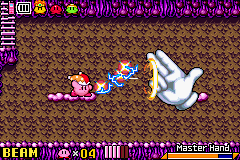
Since HAL Laboratory was the main developer for the first two Super Smash Bros. games, and Masahiro Sakurai was the original creative mind behind both that and the Kirby series, the two series share a lot of design aspects and have been closely intertwined, though this has become gradually less true over time with Sakurai's departure from HAL Laboratory in the mid 2000s. There are many ways in which the Super Smash Bros. series has influenced the Kirby series since the former's inception, but the following are the most notable:
- Kirby's principal voice actor Makiko Ohmoto first voiced him in Super Smash Bros. on the Nintendo 64. It is also arguable that Kirby's modern rounder appearance was largely shaped by his appearance in that title (which was the first finished game to depict him in 3-D).
- The Smash Bros. Copy Ability is directly inspired by Kirby's moveset in the Super Smash Bros. series, and has appeared in multiple games.
- Master Hand and Crazy Hand have appeared in Kirby & The Amazing Mirror as foes for Kirby to fight.
- The modern designs of Meta Knight and the Halberd largely take their cues from Super Smash Bros. (specifically from Brawl onward).
- Many arrangements of Kirby songs from Super Smash Bros. (particularly Melee) inspired arrangements or remixes in subsequent Kirby games (the most notable ones being the Melee arrangement of Green Greens and Fountain of Dreams (originally the Gourmet Race theme)).
- The final release version of Kirby Air Ride was built using the same base engine as Super Smash Bros. Melee.
References
- ↑ 初代『星のカービィ』開発秘話 【雑談】 — 桜井政博のゲーム作るには (official English version: Development Secrets of the Original Kirby [Grab Bag] — Masahiro Sakurai on Creating Games; also appearing in print in the 2017/05/11–18 issue of Weekly Famitsu as a special edition of Sakurai's "Think about the Video Games" column [1/2, 2/2; Wayback Machine snapshots exist of 1/2, 2/2]
| ||||||||||||||||||||||||||
| ||||||||||||||

